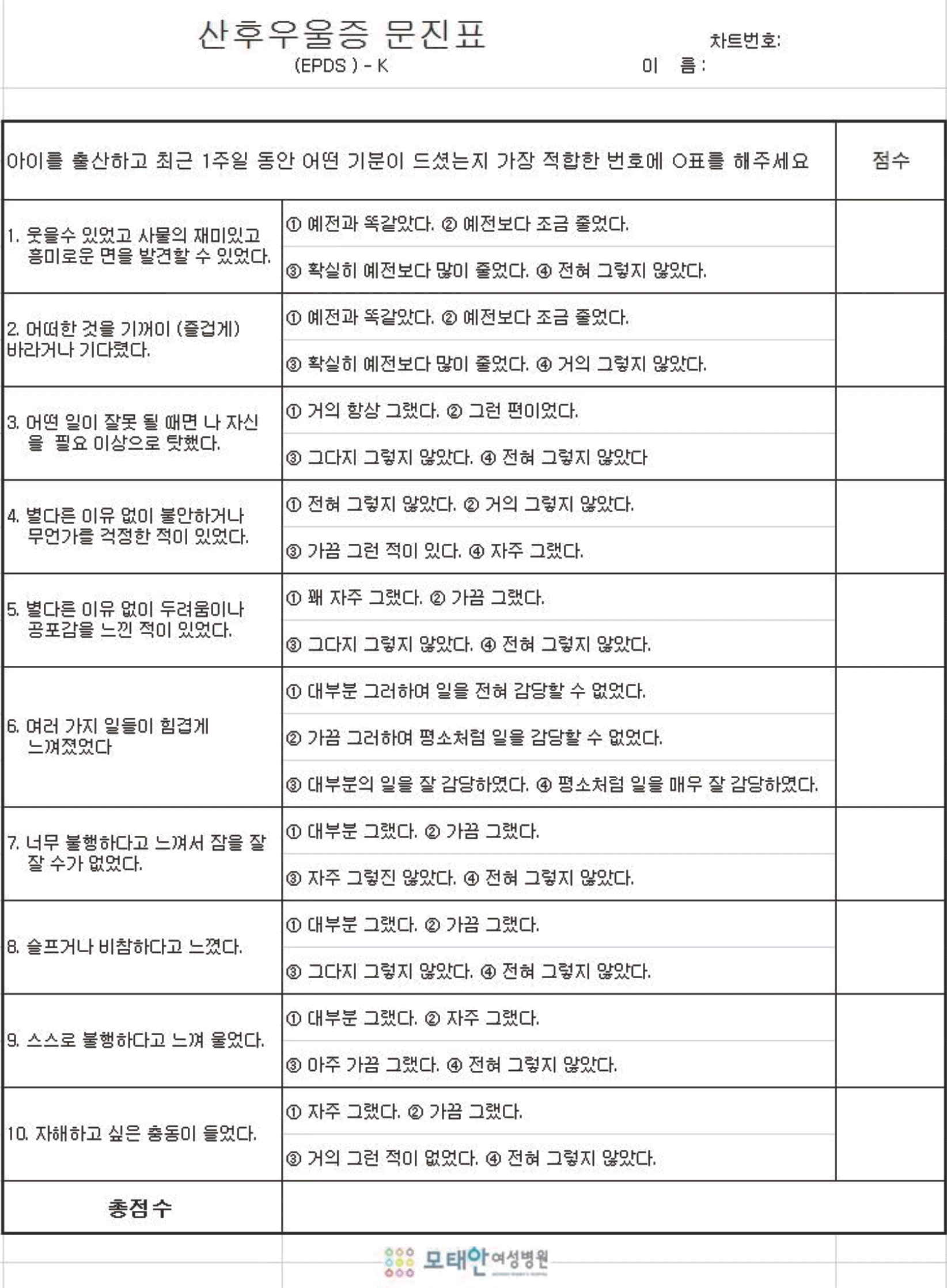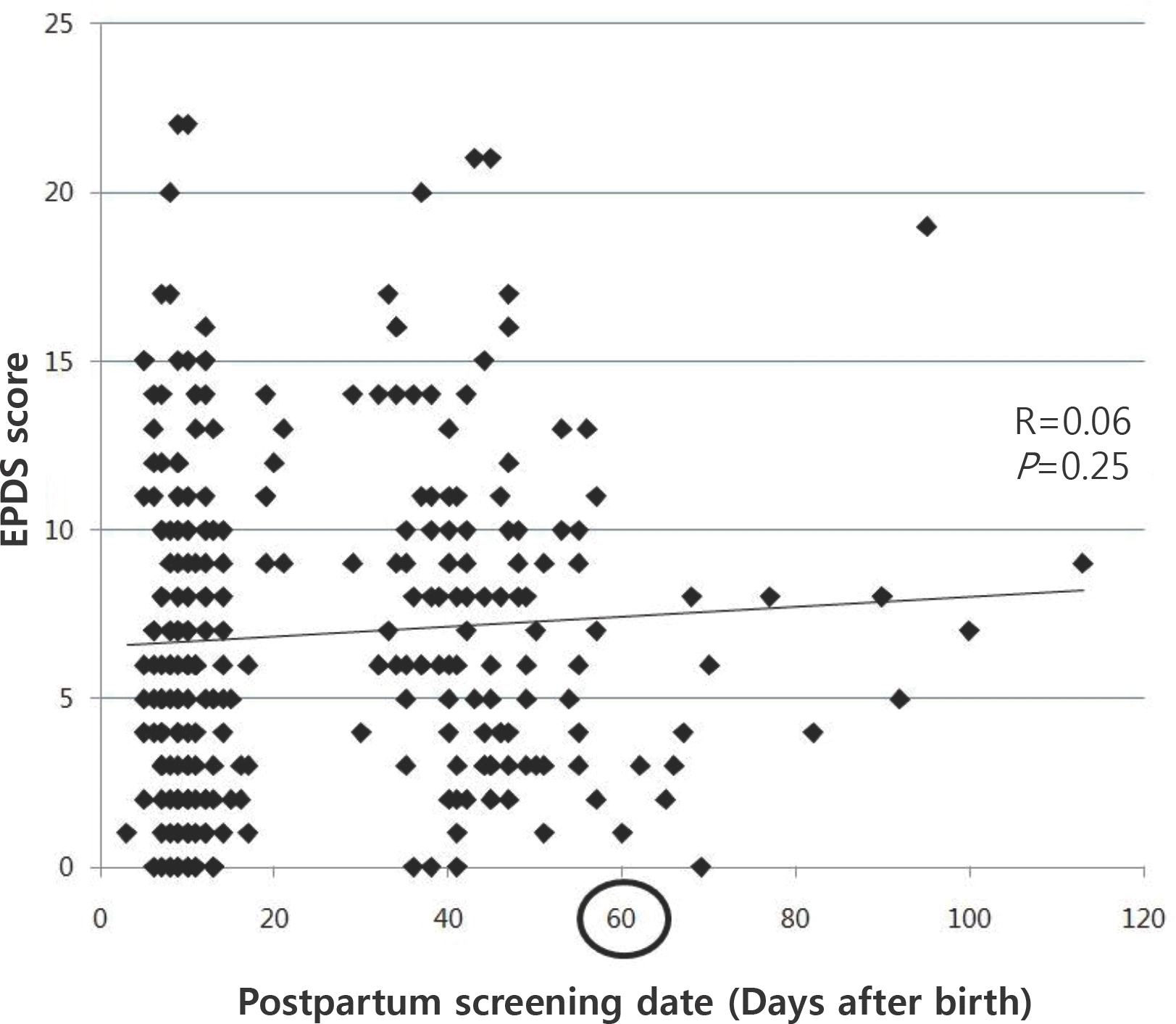Abstract
Purpose
Postpartum depression (PPD) is a common postnatal problem. PPD has a negative influence on maternal functioning and child development. We examined the result of Edinburgh Postnatal Depression Scale (EPDS) after delivery.
Methods
Three hundred two postpartum mothers were enrolled in the study. The Korean version of EPDS was completed and scored at postpartum visits. Mothers whose score was 10 or more were classified as an EPDS positive for PPD. We reviewed their medical records and determined risk factors for positive EPDS result.
Results
The positive rate of EPDS was 27.8% (84/302). Among various factors, a newborn's body weight more than 4.0 kg was statistically related to the positive result. The positive rate of EPDS was significantly higher when performed within postpartum 60 days than after postpartum 60 days. Among 84 positive women, only three mothers visited a psychiatric clinic for further evaluation and management of PPD.
Go to : 
References
1. Yang SJ, Kim JM. Diagnosis and treatment of postpartum depression. Korean J Biol Psychiatry. 2006; 13:3–10.
2. Bobo WV, Yawn BP. Concise review for physicians and other clinicians: postpartum depression. Mayo Clin Proc. 2014; 89:835–44.

3. Ryu AL, Kim TH, Lee HH. Evaluation of risk factors for the postpartum depression with Edinburgh Postnatal Depression Scale (EPDS) score. Korean J Perinatol. 2010; 21:74–80.
4. Gjerdingen DK, Yawn BP. Postpartum depression screening: importance, methods, barriers, and recommendations for practice. J Am Board Fam Med. 2007; 20:280–8.

5. Hirst KP, Moutier CY. Postpartum major depression. Am Fam Physician. 2010; 82:926–33.
6. Yook JH, Ahn GH, Kim YY, Han YJ, Lee SW, Kim MH, et al. Associated factors for the development of postpartum depression at 1 month postpartum. Program and Abstract, the 97th Annual Meeting of Korean Society of Obstetrics and Gynecology; 2011 Sep 30-Oct 1; Seoul. Seoul: The Korean Society of Obstetrics and Gynecology;2011. p. 172.
7. Kim YK, Hur JW, Kim KH, Oh KS, Shin YC. Clinical application of Korean version of Edinburgh Postnatal Depression Scale. J Korean Neuropsychiatr Assoc. 2008; 47:36–44.
8. Kim MW, Yang HS, Kim JR. A study on agreements among screening tests and related factors with postpartum depression. Korean J Obstet Gynecol. 2009; 52:1133–43.
9. Korean Diabetes Association, Korean Diabetes Research Foundation, International Conference on Diabetes and Metabolism 2013. Diabetes fact sheet in Korea. 2013.
10. Oh ES. The effect of postpartum depression on the development of children. Korean J Pediatr. 2005; 48:469–75.
11. Thurgood S, Avery DM, Williamson L. Postpartum depression. Am J Clin Med. 2009; 6:17–22.
12. Henshaw C, Foreman D, Cox J. Postnatal blues: a risk factor for postnatal depression. J Psychosom Obstet Gynaecol. 2004; 25:267–72.

13. Cho HJ, Choi KY, Lee JJ, Lee IS, Park MI, Na JY, et al. A study of predicting postpartum depression and the recovery factor from prepartum depression. Korean J Perinatol. 2004; 15:245–54.
14. Watkins S, Samantha MB, Zolnoun D, Stuebe A. Early breastfeeding experiences and postpartum depression. Am J Obstet Gynecol. 2011; 118:214–21.

15. Milgrom J, Gemmill AW. Screening for perinatal depression. Best Practice & Research Clin Obstet Gynaecol. 2014; 28:13–23.

16. Cox JL, Holden JM, Sagovsky R. Detection of postnatal depression: development of the 10-item Edinburgh Postnatal Depression Scale. Br J Psychiatry. 1987; 150:782–6.
17. Han K, Kim M, Park JM. The Einburgh Postnatal Depression Scale, Korean version: reliability and validity. J Korean Soc Biol Ther Psychiatry. 2004; 10:201–6.
18. Sit DK, Wisner KL. The identification of postpartum depression. Clin Obstet Gynecol. 2009; 52:456–68.
Go to : 
Table 1.
Various factors related to postpartum depression
Table 2.
EPDS score according to the postpartum screening date




 PDF
PDF ePub
ePub Citation
Citation Print
Print




 XML Download
XML Download